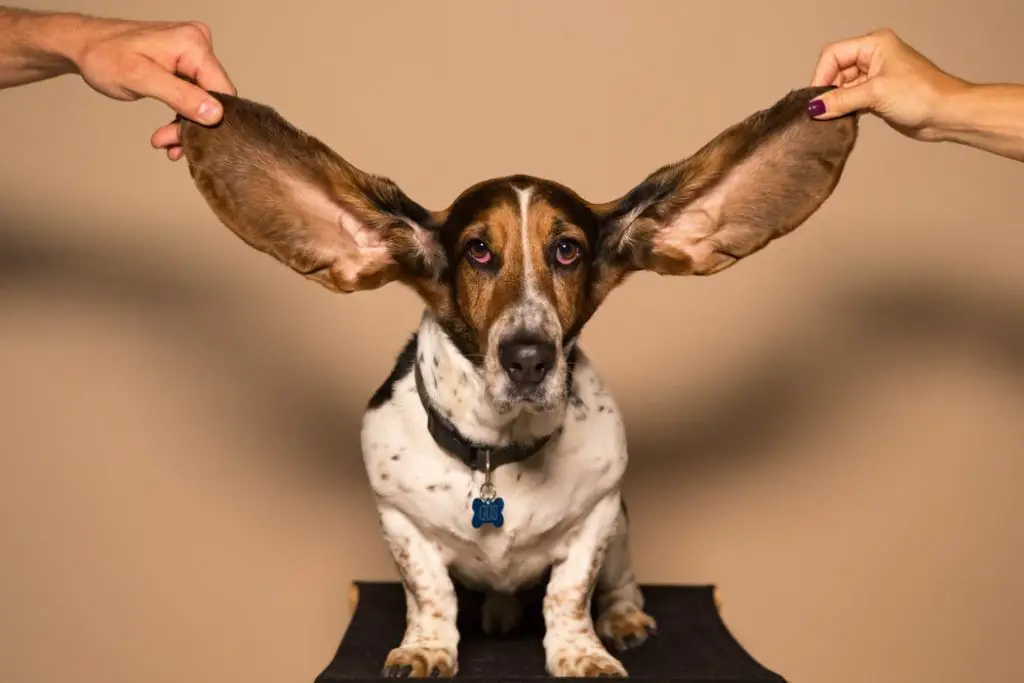One of the top common ailments for canines is ear infections. It’s hard when are our dogs are not feeling well and unable to verbally communicate exactly what is causing them pain.
Responsible dog owners are always paying attention to any unusual behavior or tell-tale signs of illness. The only way dogs can let us know is by their body language and behavior changes. Ear infections are common enough that we should be familiar with the symptoms.
Just like with people, dog ear infections can be painful. As you care for your dog, you will need to know the signs, symptoms and how to treat a dog ear infection at home without a vet when it’s necessary.
Related Articles:
- A Review of the 5 Best Slow Feed Dog Bowls
- A Review of the 5 Best Retractable Dog Leashes
- A Review of the 5 Best High Fiber Dog Foods For Anal Gland Problems
- The 5 Pawsitively Best Dog Nail Grinders
- How to Get a Dog To Take a Pill
- Learn The Secrets Of How to Clip a Dog’s Nails Safely!
In this article, How to Treat a Dog Ear Infection at Home Without A Vet, we’ll look at the following:
- Causes of ear infections
- Three types of ear infections
- The source of ear infections
- Signs and symptoms
- Home treatment options
- Preventive tips
** When dog owners are unable to seek the counsel of their veterinarian, they want to know how to bring relief to their canine family member.
The ideas in this article are not a substitute for professional veterinarian care, but it will offer you options for how to treat a dog ear infection at home without a vet.
Ear infections can afflict any breed of dog. The shape of the dog’s ear canal and the style of ears can be factors for why some dogs are more vulnerable than others. The dog’s genetic history can contribute to whether their skin type is susceptible to infections.
The American Kennel Club says that floppy-eared dogs like cocker spaniels, hounds, poodles, retrievers, and schnauzers are more vulnerable to ear infections. Dogs with ears that stand upright tend to dry out quicker.
Relevant Articles:
- A Review Of The Top 5 Best Tactical Dog Harnesses
- How to Potty Train an Older Dog in an Apartment
- How to Measure a Dog for a Harness
- A Review of the 6 Best Dog Harnesses for Hiking
How to Treat a Dog Ear Infection at Home Without a Vet: Causes of Ear Infections
There are many reasons your dog could have an ear infection. When you need to know how to treat a dog ear infection at home without a vet, it’s helpful to know the why they happen.
- An overgrowth of yeast and bacteria in the ear.
- Floppy ears that trap moisture and debris.
- Waxy buildup inside the ear.
- Trapped moisture from swimming.
- Foreign matter or debris in the ear.
- Injuries to the ear
- Auto-immune disorders and allergies
In the case of chronic allergies, that is a sign that your dog’s overall system is under stress. Canine auto-immune diseases such as joint inflammation and skin disease can make these dogs more vulnerable to frequent ear infections.
Environmental and food allergies can also be a factor for chronic ear infections. It’s best to work with your local veterinarian to determine the root cause for repetitive ear infections.
3 Types of Ear Infections
You might not be able to determine the type of ear infection that is inflicting your dog. However, when determining how to treat a dog ear infection at home without a vet it’s good to know that dogs can have the symptoms for any of the three types of infections.
- Otis media is inflammation and infection in the middle part of the dog’s ear.
- Otis interna is inflammation and infection in the inner part of the dog’s ear.
- Otis externa is inflammation and infection in the external part of the dog’s ear
Otis externa is the most common type of infection. This type affects the cells lining the external portion of the dog’s ear canal. It’s not uncommon for dogs to have more than one type of ear infection going on at the same time.
How to Treat a Dog Ear Infection at Home Without a Vet: Know the Source of Infection

The four main sources of infection include yeast, bacteria, foreign debris, and ear mites.
Once we learn a bit more about the source of the infection, we can learn how to treat a dog ear infection at home without a vet.
It’s interesting to keep in mind that it’s natural to have yeast cells and healthy bacteria present in a dog’s ears. The problem arises when it’s in an abundance of yeast or bacteria that can lead to an infection.
Yeast. The most prevalent type of yeast overgrowth found in dog’s ears is known as Malassezia. This source of infection isn’t usually a problem in dogs with a strong immunity and healthy skin.
A yeast infection can be recognized as a thick brown discharge that has an unpleasant odor.
Bacteria. Dog’s that develop an abundance of bacteria in their ears usually have some type of debris present.
Foreign debris. Once debris is trapped inside the ear, it can contribute to an abundance of bacteria. Debris could include lake water, ear mites, dirt, grass seeds and wax build-up. If your dog has floppy ears, it’s important to clean them and dry them after hiking and swimming.
Ear Mites. These little parasites are a type of mange that causes ear infections in dogs and cats. When your dog is infected, it will look like “coffee grounds” inside their ear.
Relevant Articles:
- Ultimate Guide: How To Take Care Of A Puppy
- Ultimate Guide: How To Take Care Of A Dog
- Ultimate Guide: How To Take Care Of A Senior Dog
- The Benefits of Owning a Dog
- Top 12 Tips for First Time Dog Owners
- How to Train a Dog
How can my dog get ear mites?
Ear mites are quite contagious. Another infected dog or cat might have passed it along to your pet from walking in the park or during socialization.
We know the four ways a dog’s ear could become infected, now we’ll look at the symptoms of an ear infection.
How to Treat a Dog Ear Infection at Home Without a Vet: Look for the Symptoms

The only way your dog can let you know they are in pain is with body language. When your dog begins to behave differently, write down the date you noticed those symptoms.
Symptoms of Ear Infections (caused by bacteria or yeast overgrowth)
- Pain
- Smelly bad odor near the ears
- Red irritated skin inside the ears
- Ears feel hot
- Frequent head shaking
- Rubbing ears on surfaces
- Yellow, green, or brown discharge
- Head tilting towards the ear that has the infection
Symptoms Specific to Ear Mites
- Frequently shaking the head
- Excessive scratching with scratch marks on the back of the ear
- Crusty or scabby under the ear flap
- Clumps in the ear canal that look like “coffee grounds”
- Hearing loss
Related Articles:
- A Review of the Top 5 Best Dog Bones For Aggressive Chewers
- How to Get a Picky Dog to Eat
- A Review Of The Top 5 Best Bone Broths for Dogs
- How to Stop a Dog from Pooping in the House at Night
- How to Potty Train an Older Dog in an Apartment
- How to Grind Your Dog’s Nails
Severe Infection Symptoms
- Excessive scratching, chewing their skin
- Loss of balance
- Hearing loss
How to Treat a Dog Ear Infection at Home Without a Vet: Treatment Options

If you are unable to get your dog to the veterinarian, due to being out of town, you are in a remote area, or it’s late at night, you can try these topical remedies for how to treat a dog ear infection at home without a vet.
Word of Caution: Do NOT use rubbing alcohol or hydrogen peroxide in your dog’s ear. Both these solutions will irritate the already inflamed area.
Related Articles:
- A Review of the Top 5 Best Brooms For Dog Hair
- A Review of the 5 Best Peanut Butters for Dogs
- A Review of the 4 Best Dog Shampoos for Itchy Skin
- A Review of the 5 Best Dog Brushes For Short Hair
- A Review of the 6 Best Dog Harnesses for Hiking
4 Home Remedies for How to Treat a Dog Ear Infection at Home Without a Vet:
- Green Tea: Boil 8 oz. of water, add 2 green tea bags. Steep for 10 minutes. Sponge the area inside the ear flap with green tea to reduce inflammation.
- Purchase an Ear Cleanser at your local pet store. Look for enzymatic cleansers specifically made for canine ears. The cleaners might also contain hydrocortisone to reduce itching and inflammation.
Pet MD - Dog Ear Cleaner Wipes - Otic Cleanser for Dogs to Stop Ear Itching, and Infections with Aloe and Eucalyptus - 100 Count
- Enzymatic Ear Wipes with aloe.
- Grapeseed Extract: This antioxidant, antibacterial, antiviral, and antifungal extract can be used to clean the ears. Mix 10 drops of grapeseed extract with ½ oz. of pure aloe vera juice. Using a soft facial cleansing round, gently clean the ears.
NutriBiotic – GSE, 2 Oz Liquid | The Original Grapefruit Seed Extract Premium Concentrate with Bioflavonoids | Potent Immune & Overall Health Support | Vegan, Gluten Free, Non-GMO
$12.98 in stock
- Vinegar and Water: To reduce the itch and discomfort combine ¼ c. water with a ¼ c. apple cider vinegar. Soak a cotton facial cleansing round in the solution, clean the ear and squeeze the solution into the ear simultaneously.
In the case of ear mites, wash all the dog’s bedding and mats. Remember to include cleaning your rugs, furniture, and vehicle.
** Contact your local veterinarian for further treatments. In some cases, oral medication and prescription ear drops will be needed to treat the infection.
Related Articles:
- A Review Of The Top 5 Best Salmon Oils for Dogs
- The Best Canned Dog Food for Dogs with Sensitive Stomachs
- How to Cook Liver for Dogs
- A Review of the 5 Best High Fiber Dog Foods For Anal Gland Problems
How to Treat a Dog Ear Infection at Home Without a Vet: Prevention Tips

Dog owners can do their part in trying to prevent their dog from an ear infection. A few tips would include a healthy balanced diet and routine ear cleaning.
Keep your dog’s ears clean and dry.
One suggestion for cleaning your dog’s ears is combine ½ witch hazel cleaner with ½ water. Dampen a soft round cleansing pad with the cleaning solution and clean around and in your dog’s ears.
Related Articles:
- A Review Of The Top 5 Best Carpet Cleaner Solutions for Dog Urine
- A Review Of The Top Best Silent Dog Whistles
- A Review Of the Top 5 Best Artificial Grasses For Dog Potty
- A Review of the Top 5 Best Dog Carrier Backpacks
- A Review of the 5 Best Dog Frisbees
Seek the Counsel of a Veteranarian
As dog owners you desire to do your best with how to treat a dog ear infection at home without a vet, however once it is possible, contact your veterinarian, with the following information:
- Your dog’s breed or ear style
- Dog’s medical history (previous infections & known allergies)
- Ear infection symptoms
- Date you first noticed symptoms
- Home treatments
- Recent activities, like swimming
- Grooming habits
- What your dog is eating and drinking
By keeping our dog’s ears dry and routine grooming, we can hope to avoid painful ear infections. We all know life and accidents happen and not at convenient times.
Related Articles:
- A Review Of The Top 5 Best Dog Whistles
- A Review of the 5 Best Dog Muzzles
- A Review Of The Top 5 Best Dog Clickers
- How to Build an Outdoor Dog Potty Area on Concrete
If the need to learn how to treat a dog ear infection at home without a vet occurs, you can use the four home remedies mentioned. Hopefully this will relieve your dog until you can seek proper veterinarian care.
“It’s not what we have in life, but who we have in our lives that matters.” Author Unknown
Please read our Legal Disclaimer



